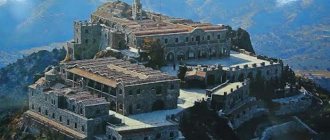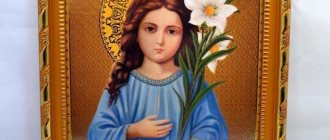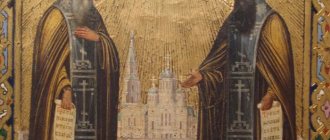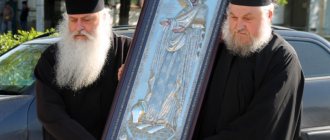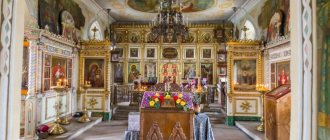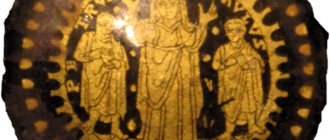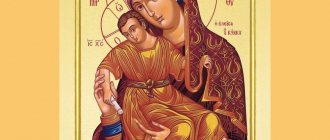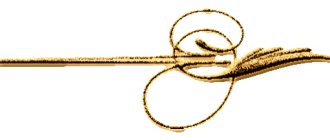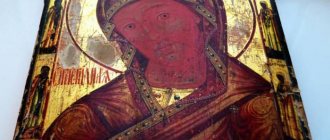Description and history of origin
According to legend, Kikkokista was written during the life of the Holy Virgin. Apostle Luke, under the guidance of Archangel Gabriel, painted three portraits of the Virgin Mary. One of them is “Eleus” (“Merciful”). Upon completion of the work, the saint showed the icon to the Most Holy One and she blessed it, endowing it with amazing miraculous power. The shrine received its name from Mount Kykkos, located on the island of Cyprus.
In the icon, the Mother of God holds little Jesus in her left hand, and touches Christ’s head with her cheek. What makes this picture unusual, from an iconographic point of view, is the baby’s lively and dynamic pose. His legs and arms are bent, his torso is turned frontally, and his legs are turned to the left. It's like he's playing in his mother's arms.
In the Orthodox capital
The relic did not reach the island immediately. Initially, the apostle took the icon to Egypt, where it remained until the 8th century. This period was characterized by the development of iconoclasm, which lasted until the beginning of the 9th century. To save the shrine from destruction, it was sent from Egypt to Byzantium. Along the way, the ship was captured by Arab pirates. The icon did not interest them and was consigned to oblivion. Some time later, around 980, the pirate ship was attacked by the Greeks. By that time, iconoclasm in Byzantium was over, and the image went to Constantinople.
Here the icon was kept for many years as the greatest Orthodox shrine, until it was sent to Cyprus.
Transfer to Cyprus
The shrine was moved to the island at the beginning of the 11th century, during the reign of Emperor Alexei Komnenos. In a dream, the Mother of God herself appeared before him and ordered him to send the icon to Cyprus. At the same time, a vision appeared to the hermit Isaiah, who lived on Mount Kykkos. In it he saw that a miraculous icon depicting the Blessed Virgin with a baby in her arms would come to the island. The elder turned to the ruler of the island, and he turned to Emperor Alexei, to deliver the shrine to Cyprus.
The Kykkos Monastery was built especially for the Gracious Icon, where it remains today.
Miracles
The Kykkos icon is rightfully considered miraculous. Pilgrims from all over the world come to see it every year. The Merciful Mother of God showed her power upon her arrival in Cyprus. When it was solemnly carried around the island, not only people, but also plants bowed down. Even now, on the way to the monastery, you can see bent trees. Legends about true miracles performed by the Merciful Mother of God have survived to this day:
- One monk was thirsty and turned to the Holy Virgin. He heard a voice that told him to hit the stone. The monk fulfilled the command, and water poured out of the stone. It was a life-giving source, through the waters of which many found healing from their ailments.
- The healing power of the icon is great: the mute from childhood acquired the gift of speech, the dying came to life, the sick recovered.
- During all major fires, the icon remained unharmed.
- After the fires, the clergy saw a service being held in the empty temple, and the Virgin in shining clothes walking around.
- During the restoration of the monastery after a fire, the roof collapsed on the workers. The Mother of God showed her mercy here too; no one was hurt.
Kikkokista is capable of not only giving her mercy, but also punishing for disrespectful attitude:
- One unbeliever decided to hit the icon and his hand withered. In memory of this miracle, an iron hand was hung to the icon so that it would serve as a reminder to everyone that the power of the Holy Virgin is truly great.
- When the Turkish governor extorted money from the monastery, the clergy hid the shrine and began to pray. And an unprecedented downpour began. And it lasted three days. The thunderstorm and lightning frightened the Turks so much that they no longer came to the monastery.
The icon of the Mother of God gives her mercy to everyone who turns their prayers to her sincerely and with faith in the heart.
The Mystery of the Kykkos Icon
The Cypriot icon of the Mother of God is shrouded in mystery. It is decorated with a frame and is hidden from the view of visitors under a velvet embroidered blanket. Only the lower part of the salary remained uncovered. Those who dared to look under the veil were punished by the Mother of God. There are several theories explaining the reason for this mystery:
- order of Emperor Alexei;
- incredibly strong energy of the shrine;
- age.
The Kykkos Mother of God is one of a kind. The faces of other icons of the Mother of God and the Child are open. Only once a year does the icon leave the monastery. The priests take her to the top of the mountain and pray for rain and harvest. But even then no one dares to raise their eyes to the holy faces.
Initially, the Kykkos Icon of the Mother of God was located in Egypt, in one Christian community
One of the names of the icon is “Merciful”. It received its other name “Kikkiotis” from the name of Mount Kykkos, which is located on the island of Cyprus. Initially, the icon was in Egypt, in one Christian community, to which the Apostle Luke gave the icon.
In 980, the Arabs began to persecute Orthodox Christians, so the miraculous image was taken to Constantinople, where it was located until the reign of Emperor Alexius Komnenos. Alexei Komnenos ruled at the end of the 9th - beginning of the 12th century. But then the image of the Mother of God was taken back to the island of Cyprus.
The miraculous image of the Kykkos Mother of God was taken to Constantinople, where it remained until the beginning of the reign of Emperor Alexius Komnenos
And this happened in a rather strange way. The Cypriot ruler, Manuel Vitomis, got lost in the mountains while hunting. He became very angry and severely beat the hermit monk Isaiah who met along the way.
Abba Isaiah the Hermit - ascetic, church writer
For this terrible act, Manuel suffered a serious illness. Isaiah had a vision that through his efforts the holy icon, painted by the Evangelist Luke, would be brought to Cyprus. Isaiah labored a lot for this cause. He began to build a temple for the icon of the Virgin Mary. When Manuel came to him, asking for forgiveness, Isaiah commanded him to return the icon to its place.
The emperor did not immediately fulfill Manuel’s request, but only when his daughter became very ill. Then Manuel advised him to do what the monk said. After the emperor promised to return the icon to its place, the girl immediately felt much lighter.
The icon was taken to the island, where it was placed in the newly built temple. Soon a monastery was formed around the temple.
Kykkos Monastery on the island of Cyprus, where the icon of the Kykkos Mother of God is kept
The monastery was equipped at the expense of Manuel himself. This monastery began to be called imperial. The Queen of Heaven began to send miracles from her icon. People who needed help healing their illnesses began to flock here from all sides. Not only Christians, but also non-Christians believed in the power of the image.
Meaning in Orthodoxy
January 8 is the day of celebration in honor of the Kykkos Icon of the Mother of God. On this day, a service is held and an akathist to the Gracious Icon is read. This unique shrine is revered to this day. Pilgrims from all over the world come to Cyprus to pray to the sacred image of the Mother of God. Not only Orthodox Christians come to the Merciful Mother of God. Representatives of other religions also turn to her in the hope of a miracle. To those whose thoughts are pure and whose faith is strong, the Mother of God shows her mercy.
Many poems and songs are dedicated to the great icon. They were published and sold in huge numbers. A large number of lists have been written from it at different times and in different countries.
The image of the All-Merciful Mother of God on Kikkokista is a symbol of the tender love of mother and son, God’s love for people and a reminder of the great sacrifice made for them.
Where is the miraculous image located?
The icon that Luke painted is still kept in Cyprus, in the monastery on Mount Kykkos. The monastery was repeatedly attacked by enemies, but their attempts to destroy the monastery were in vain.
Lists of the image are located in different countries of the world, including in Russia, where a copy ended up in the 17th century. The most famous icon located in Rus' can be called a list kept in Moscow, in the Orthodox Conception Monastery. The image is the main shrine of the monastery. The first records about it date back to the 18th century. The icon was placed in the Church of the Nativity of the Blessed Virgin Mary.
At the beginning of the twentieth century, during the oppression of Orthodoxy, when Soviet power destroyed churches and monasteries, this monastery was initially closed, and later destroyed. But the image of the Mother of God has been preserved. For a long time it was kept in the Elias Church. The sisters of the destroyed monastery looked after him, prayers were performed in front of the icon. In 1999, the Church of the Conception was restored, and the icon returned there.
The icon is kept in the monastery on Mount Kykkos (Cyprus)
Conception Monastery
Revered list of the “Merciful” icon in the Conception Monastery
Honored Lists
After the glorification of “Kikkotissa”, lists of the miraculous icon began to appear everywhere. The earliest list dates from the first half of the 12th century and is located on Mount Sinai, in the monastery of St. Catherine. On it, the Virgin Mary sits on a throne, turning to the left. The Most Holy One bowed her head to the baby sitting in her arms. The image of the Merciful Mother of God was copied from “Kykkotissa” for the main icon of Athos – “It is worthy to eat”, which testifies to the widespread reverent veneration of the Kykkos icon. In Greece, the list of the Church of the Icon of the Mother of God in Thessaloniki and the Thessalonian list stand out. They are credited with miraculous properties and power.
On the early lists, some details changed: the baby’s pose, the color and presence of the dress, the direction of the gaze. The icons themselves were made larger. The first lists of the Most Gracious Mother of God in Rus' appeared at the end of the 16th century. The most famous and revered are “Eleusa Kykkotissa”, which is located in the Tretyakov Gallery and “Our Lady of Eleusa Kykkos” in the Suzdal Museum. The Zachatovsky Monastery houses a list dating back to the 18th century. It depicts the Virgin Mary with one ear open. She seems to be listening to prayers addressed to her. The people called the Conception Icon “The Listener.”
The image of the Mother of God and Child is revered by Orthodox Christians all over the world. Copies from “Kikkotissa” exist large and small, on frescoes and icons, in fine art and architecture. People turn to the lists of the miraculous icon with prayers for help and intercession. And everyone is rewarded according to his faith.
The icon of the Kykkos Mother of God is half covered with a shroud so that no one can see the holy face
The icon of the Mother of God of Kykkos has an amazing feature. It is not known from what time, but the icon is half covered with a shroud from the upper left corner to the lower right corner, so that no one can see the holy face of the Mother of God and Jesus Christ. There is a legend that the patriarch, having gained insolence, looked into the eyes of the Mother of God and immediately became blind.
It is not known from what time, but the icon is half covered with a veil from the upper left corner to the lower right corner, so that no one can see the holy face of the Mother of God and Jesus Christ
In Rus', miraculous lists appeared already in the 17th century. One of these icons was located in Moscow in the Conception Monastery. This was the main shrine of the convent. But, in the 1920s, the Cyprus Icon of the Mother of God was transferred to the Church of Elijah the Prophet in Obydensky Lane in Moscow. In 1999, the life of the monastery was revived again and the icon was returned to its original place.
The real original icon is located on the territory of the Kykkos Monastery. The merciful Mother of God protects the entire Russian people to this day. Even now people pray to her, asking for her intercession and help. The Merciful Mother of God will always help if you turn to her with a pure heart.
Eleusa
type of image of the Mother of God, where the Child Christ, sitting on Her hand, presses his cheek to Her cheek
What can you ask for?
Most often, people turn to the icon of Our Lady of Mercy with a prayer for healing from illnesses for themselves and their loved ones. Women ask for the gift of offspring and peace in the family. Our Lady helps with drought and epidemics. Sincere prayer works real miracles.
About rain in dry times
Drought is a big problem for humanity. It destroys crops and causes famine and disease. During a prayer service for rain, the icon of the Mother of God is taken to the top of the mountain and the veil is opened. The face of the Blessed Virgin is turned to heaven.
Helps in conceiving a baby and curing infertility
It often happens that spouses passionately want, but cannot conceive a child. Modern medicine also turns out to be helpless. After countless attempts, people often turn to faith. The image of the Mother of God is a symbol of boundless maternal love and harmony with the child. It is she who often turns to women to get rid of infertility.
You need to pray for conceiving a child correctly. Thoughts and soul must be pure, devoid of sinful habits and passions.
About getting rid of deafness and muteness, headaches, bleeding
At all times, people turned to the icon for help in healing from illnesses. Prayer is a special form of addressing the saints. However, those who cannot resort to the words of prayer due to their illness - deafness or dumbness - can turn to the face of the Most Holy One with their hearts. It also helps soothe headaches and stop bleeding. You can pray to the Most Gracious Mother of God both in church and at home.
About stopping natural disasters
During natural disasters, special prayer rituals are performed. Believers turn to the Mother of God all together, which greatly increases the power of prayer. Often, sacred rites during natural disasters include fasting and repentance of believers. There was also a procession with the icon through the affected areas.
About improving family relationships and ending quarrels
In Orthodoxy, family and family relationships are of great importance. The family hearth is a “small temple”. To improve relationships in the family, you need to regularly turn to the Mother of God as a Gracious patroness. After a quarrel, a prayer service can help you realize that you were wrong and make the right decision. Turning to the image even helps avoid divorce.
About ending the lack of money
You can also turn to the icon of the Blessed Virgin in case of a difficult financial situation. If a person works honestly, but cannot get out of debts and a difficult situation, prayer before the “Merciful One” will help him.
About permission from adversity
It happens that there comes a dark streak in life. In this case, you also need to turn to faith. The Mother of God can protect from negativity, sorrow and sadness.
About salvation from epidemics
During the epidemic, the inhabitants of the island often turned to the clergy with a request to bring the miraculous icon to the village. People believed in the great power of the shrine. The mere presence of an icon in the village could stop all troubles.
The Kykkos Mother of God helps in conceiving a child and getting rid of infertility
What does it help with and what do they pray to the Mother of God of Kykkos? They pray to her:
- about rain in dry times;
- about conceiving a child;
- about cure for female infertility;
- from getting rid of deafness, muteness;
- from getting rid of headaches, bleeding;
- about the end of terrible disasters on earth;
- about ending the lack of money;
- about salvation from epidemics.
The Mother of God of Kykkos could pull a person straight from the other world. You don’t have to read complex and long words of prayer, but simply turn to the Mother of God for help in your own words.
How to pray in front of an icon
Orthodox Christians treat the Mother of God with special reverence. During prayer, it is strictly forbidden to look under the veil that hides the face of the Holy Virgin. However, you can look at the image depicted on the bedspread. For every request that a person makes to the Mother of God, there is a special prayer compiled by holy people. It allows you to tune your soul and mind in the right way. If a person does not know the words of the prayer, belongs to another religion or is dumb, then he can turn to the Holy Virgin in his own words or mentally. The words of prayer must be pronounced with reverence. The mind should be calm and devoid of emotions. The request made in front of the icon should not contain conditions to the Blessed Virgin.
It is important that the prayer is not read “for show.” You need to believe that this is a living dialogue with the Most Gracious Mother of God and then she will answer and show a miracle to the one praying.
Veil of the Virgin Mary
It is not known exactly when the “Merciful” icon of the Mother of God of Kykkos was covered with a veil covering the holy faces, and now it is constantly hidden behind a red velvet veil. Only once a year is the face of the Mother of God revealed during a prayer service, but there is a legend that the patriarch who dared to look directly into Her eyes was once blinded.
Lyrics
On the day of remembrance of the Kykkos Icon of the Mother of God, on January 8 and November 25, a festive service is performed. The main texts of any worship service are prayers and chants.
Prayer
During the service, believers read a common prayer. Common prayer has great power and meaning.
“O Most Holy and Most Blessed Mother of our Lord, God and Savior Jesus Christ, Merciful Mother of God and Ever-Virgin Mary! Falling before Your holy and miraculous icon, we humbly pray to You, our Good and Merciful Intercessor: listen to the voice of our sinful prayers, do not despise the sighs from the soul, seeing the sorrows and misfortunes that have befallen us, and like a truly loving Mother, striving to help us helpless, sad, Those who have fallen into many and grave sins and continually anger our Lord and Creator, pray to Him, our Representative, not to destroy us with our iniquities, but to show us His philanthropic mercy. Ask us, O Lady, from His goodness, bodily health and spiritual salvation, a pious and peaceful life, fruitfulness of the earth, goodness of the air, well-timed rains and a blessing from above for all our good deeds and undertakings, and as of old you mercifully looked upon the humble praise of the novice of Athonite. , who sang a song of praise to You before Your most pure icon, and You sent Archangel Gabriel to him to teach him to sing the heavenly song, with which the angels of the mountain glorify You, graciously accept our prayer now fervently offered to You, and bring it to Your Son and God, may He be merciful He will be a sinner for us, and He will add His mercy to all who honor Thee and worship Thy holy image with faith. O All-Merciful Queen, All-merciful Mother of God, stretch out Your God-bearing hands to Him, in His image, as if You were carrying a baby, and beg Him to save us all and deliver us from eternal destruction. Show us, O Lady, Your generosity: heal the sick, comfort the afflicted, help the needy, make us all prosperous to bear the yoke of Christ in patience and humility, grant us a pious end to this earthly life, receive a Christian shameless death, and inherit the Heavenly Kingdom, through Your maternal intercession to To Christ our God, who was born of You, and to Him with His Originless Father and the Most Holy Spirit, befits all glory, honor and worship, now and ever, and unto the ages of ages. Amen".
Troparion
The troparion is sung at the beginning and end of the service. It reveals the essence of this holiday. His words are:
“Let us pray, people, with boldness to the Merciful Queen Theotokos, and tenderly cry to Her: send down, O Lady, Thy rich mercies, preserving Thy sinful servants in health and prosperity. Heal the sick, comfort the sorrowing and help the needy. And grant us, O Most Merciful One, to end this earthly life piously, to receive a Christian shameless death and to inherit the Heavenly Kingdom. Deliver our city from every evil situation, protecting it with Your merciful intercession. Grant peace and seek salvation for our souls.”
Kontakion
After the troparion, kontakion is performed. It more fully reveals the meaning of the event being sung and reflects its other side:
Kontakion 1
“Chosen from all generations, the Virgin Mother of the Lord God Most High, in the radiant glory of heaven, above the Cherubim and Seraphim, to the Lady Queen, incline Your mercy towards us sinners, quench the sadness of our hearts; spread Your honorable cover over us, visit our sorrowful life, there is no other help for the Imams, there is no other hope for the Imams except You, the Mother of our race. In fear and trembling before the greatness of Thy mercy, on bended knee, we ask Thy intercession before Thy immortal Son, calling with tenderness: Rejoice, Merciful Mother of God, pouring out Thy mercy upon us.”
Kontakion 2
“Seeing You upon the clouds, spreading Your honorable cover, and thereby protecting us, we cry out to God with gratitude: Alleluia.”
Kontakion 3
“The power of the Most High guarded You, when with infant feet You created the ascent of the stairs of the temple of the Lord, and we, sinners, trusting in Your Mother’s mercy, sadly pray: lead us up the ladder of salvation; let us draw near to the throne of the glory of God, calling with gratitude: Alleluia.”
Kontakion 4
“Suffering desperate storms in our hearts, having depended on our lives in sins, we resort to You, Mother of God, and humbly pray: give us strength of spirit, give us meekness and humility, patience and wisdom to endure all our sorrows, so that we may sing to God: Alleluia.”
Kontakion 5
“The godly star appeared to the Magi in heaven, and illuminated the den with a wondrous display, showing the King of glory lying in a manger; and with him His Mother, a pure and holy Virgin, composing songs in Her heart like an angel. O Virgin of meekness and humility, offer up our praise to the Lord: Alleluia.”
Kontakion 6
“The preaching of love, meekness and forgiveness to the world, proclaiming with Christ, Your Son, having endured all the sorrows of earth. She adopted the Apostle John and with him the entire Christian race to her mother's heart. Oh, Ever-Virgin Most Immaculate, give us our heavenly Mother, consolation and maternal warmth to those in need, and with thanksgiving we call to the Lord: Alleluia.”
Kontakion 7
“Desiring to be inseparable with your only begotten Son until death on the cross, you followed the innocent Sufferer to Golgotha and at the foot of the Cross heard the cries of an enraged host, and you suffered in silence. And fill Your very soul with this great sorrow. We, marveling at Your indescribable maternal courage, call: Alleluia.”
Kontakion 8
“The great and glorious mystery of Your ascension, Christ God, revealed to the world and seated at the right hand of God the Father, and to us who live on earth, for the villages of paradise who mourn, send down the Comforter, the Spirit of Truth and indwell us, the Giver of Life, through the prayers of Your Mother, so we call: Alleluia "
Kontakion 9
“Whoever calls on the name of the Lord will be saved, and I will pour out My Spirit on all flesh,” says the Lord. On You, Mother of God, the grace of the Holy Spirit was poured out beyond all measure. You have contained our Creator and Founder. Pour out the mercy of Your Son onto our suffering souls, and cry out with a lightened heart: Alleluia.”
Kontakion 10
“To save the world, the Good Shepherd calls everyone to salvation and draws everyone to himself; love the righteous and have mercy on sinners, save us sinners through the prayers of the Mother of God, let us sing: Alleluia.”
Kontakion 11
“Angelic singing accompanies the righteous departing after death. How will we, sinners, find salvation, how will we appear before the righteous Judge; but in Thee, Mother of God, we tenderly ask those who trust in You: save by Your Motherly intercession our souls who sing: Alleluia.”
Kontakion 12
“You have revealed the grace of Your Son to the world, Ever-Virgin, Most Immaculate, save us sinners who cry for Your mercy: Alleluia.”
Kontakion 13
“Oh, all-sung Mati, oh, Mati, filled with grace. Accept our tearful prayers to You, and at this time, boldly at Your mercy, from the depths of our souls we offer You a song: Alleluia.”
This kontakion is read three times, then ikos 1 and kontakion 1.
Greatness
During the festive service, the glorification of the Mother of God is also sung. The words of magnification are picked up by the choir and all the parishioners of the temple, and they sing until the priest makes his way through the temple.
“We magnify Thee, Most Holy Virgin, and honor Thy holy image, through which we heal our illnesses and raise souls to God.”
Troparion, kontakion, magnification
Troparion, tone 1: Merciful Virgin of the monastery of Kykkos, praise / Who is in Your arms like a child / Pray to Jesus for those who worship Your holy and all-honorable icon, / granting remission of sins and fulfillment of petitions. /how we honor forever the Mother of Thy greatness// Bringing glory to God who has so magnified Thee. Kontakion, tone 4: The source of mercy, the Merciful/Having known You as the birth of the Merciful God,/we kiss Your holy icon,/depict the spirit-bearing Luke to the south,/and the island of Cyprus has been enriched like a treasure,/so exclaiming: Rejoice//Mati of Kikkos. Greatness: We magnify You,/Most Holy Virgin/God's chosen Youth/and we honor Your holy image,/Which brings forth healing//to all who come with faith.
Real examples of help
There are a great many examples of icon help. They date back to the beginning of the 11th century, from the time of the migration of Kikkokista to Cyprus. After prayers in front of the shrine, rains regularly began during droughts. In 1668, there was an unprecedented invasion of locusts on the island. Crops suffered. People prayed, and the Mother of God sent birds to destroy the pests.
Many women who regularly prayed to Kikkokista managed to be cured of infertility and became pregnant. The blind received their sight, the dumb gained the gift of speech. The power of the icon is truly great. You need to approach it with the greatest respect and deep faith in your heart.
The legendary icon of the Mother of God in Cyprus - refers to “Eleusa”
What does this icon look like? There are 3 types of icons of the Mother of God in the world:
- Eleusa (Merciful);
- Oranta (Offerer of Prayers);
- Hodegetria (Guide to the path).
The legendary icon of the Mother of God in Cyprus refers to “Eleusa”. The difference between this image is that the faces of the saints in the image touch. This symbolizes love for all living things that exist on our earth.
The legendary icon of the Mother of God in Cyprus refers to "Eleusa"
